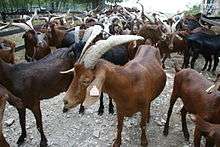Rove goat
The Rove is a breed of goat first domesticated in France. The breed was previously considered endangered, but as of 2003, more than 5000 registered Roves are on French farms. The goat was originally bred for meat, but because the current French market for goat meat is poor, farmers have begun to use the Rove for dairying, instead.[1]

Rove Goats
Description
The Rove goat is primarily characterized by its long, twisted horns; they can reach nearly 4 ft in length. The goats have a smooth coat often in red or black, but also in ash gray, red speckled with white, red mixed with gray, black with tan markings under the eyes and nose, or red and black.
It is a medium-sized goat. Females range from 100 to 120 lbs and males between 155 and 200 lbs.
gollark: You can use 7zip or GNU `tar` or something.
gollark: Look, it isn't my fault if you can't open TAR files.
gollark: Well, do so. They're part of the Web 3 edge blockchain intercloud, using hyperconverged AI networking.
gollark: Are you even using these ones?
gollark: I MAY be forced to use a memory eraser sphere.
This article is issued from Wikipedia. The text is licensed under Creative Commons - Attribution - Sharealike. Additional terms may apply for the media files.